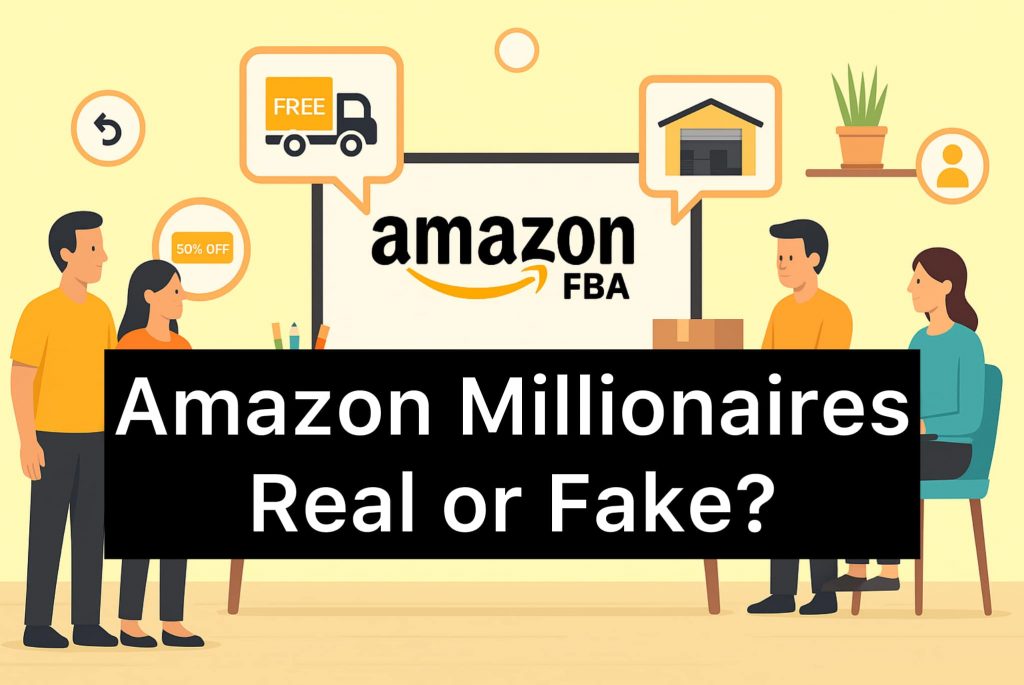Is Selling on Amazon Worth It in 2025? Affiliate vs Seller and the Risks You Should Know

Is Selling on Amazon Worth It in 2025? Affiliate vs Seller and the Risks You Should Know
? Is Selling on Amazon Worth It in 2025? The Truth Behind Affiliate, Seller Models, and the Real Risks
In 2025, the idea of making money online still holds a strong appeal—especially through platforms like Amazon, the world’s largest e-commerce giant. If you’ve ever scrolled through social media, chances are you’ve seen someone claim they’re “making thousands of dollars monthly by selling on Amazon” or “earning passive income through Amazon affiliate marketing.” The dream of earning money while working from home sounds perfect.
But here’s the real question:
Is it as easy and profitable as they make it seem?
This article aims to dig beneath the surface of these popular claims, breaking down the two most common ways people try to earn from Amazon—Affiliate Marketing and Amazon Seller (FBA)—and revealing the real challenges, risks, and truths that rarely get discussed.
? Part 1: Two Ways to “Sell on Amazon”
When someone says they’re “selling on Amazon,” they’re usually referring to one of two models:
1. Amazon Affiliate Marketing (Amazon Associates)
This is a referral-based model. You don’t sell your own product—instead, you promote existing products on Amazon using custom links. If someone clicks your link and buys, you earn a commission.
2. Amazon Seller (FBA – Fulfilled by Amazon or FBM – Fulfilled by Merchant)
This is a product-based model. You sell physical products—your own brand or resell items. If using FBA, you ship products to Amazon warehouses, and they handle storage, shipping, and returns.
At first glance, both sound like great ways to earn income. But the reality is far more complex.
? Part 2: The Amazon Affiliate Dream – Low Effort, Low Return
Amazon’s affiliate program (Amazon Associates) is one of the most well-known. It’s free to join, and in theory, you just promote links and watch the commissions roll in.
But here’s the truth:
? Commission Rates Are Shockingly Low
Amazon slashed commission rates in recent years. Current rates vary, but here’s a rough breakdown:
- Electronics: 1% – 3%
- Home goods: 4% – 5%
- Fashion: 6%
- Luxury beauty: 10%
That means if someone buys a $200 vacuum through your link, you might earn only $4–$6.
? 24-Hour Cookie Window
You only earn commission if the person buys within 24 hours of clicking your link. If they wait even a day, your referral is invalid.
? No Brand Loyalty
Unlike influencers who sell their own product, affiliate marketers must fight for trust. Shoppers don’t know or care who referred them—they trust Amazon.
? Low Traffic = No Income
To succeed in affiliate marketing, you need:
- A high-traffic blog or website
- A popular YouTube channel or TikTok
- Valuable content (reviews, tutorials, comparisons)
Without that, you’ll be lucky to make $50 a month. Many people quit after 3–6 months without seeing results.
? Part 3: Becoming an Amazon Seller – Real Business, Real Risk
Now let’s talk about the more “serious” model—selling your own product on Amazon via Seller Central.
This model has created millionaires. But it has also buried many in debt.
? What You’ll Need to Get Started:
- An Amazon Seller Central account
- Verified identity and U.S. bank account
- A product to sell (often imported from China)
- Barcodes, packaging, and branding
- Listing optimization
- Advertising budget
- FBA storage and logistics setup
? Cost Breakdown:
- Monthly Seller Fee: $39.99
- Inventory Cost: $2,000–$10,000+
- Shipping and Import Fees
- Amazon Ads Budget: $300–$1,000+/month
- Graphic design, photography, copywriting
? Hidden Risks:
- Unsold inventory ties up your cash
- Returns and refunds eat into margins
- Negative reviews destroy your product listing
- Policy violations can get your account suspended
- Chinese competitors often undercut your price
- Trademark or copyright issues can trigger legal problems
This is not a side hustle. It’s a full-fledged business that requires time, skill, capital, and risk tolerance.
? Part 4: The “Gurus” and the Marketing Machine
Here’s something else many people don’t realize:
The Amazon money-making dream is often sold to you by marketers who profit regardless of your success.
? Red Flags:
- “Join my team—no experience needed!”
- “I’ll guide you to 5-figure months in 90 days.”
- “Earn $500–$2,000 per month easily with my course.”
Behind these statements are people:
- Selling you courses ($197 to $999+)
- Referring you to software or services they get affiliate commission from
- Convincing you to buy products through their supplier connections (they earn markup)
And if you fail?
That’s your problem—not theirs. You’re just another number in their funnel.
? The Fake “Success Proof” Game
You’ll often see photos of $500 checks from Amazon, big sales dashboards, or “lifestyle” shots with luxury cars and vacations.
What you don’t see:
- That $500 check took 6 months to earn
- Sales figures are before ad spend and returns
- The lifestyle photos are stock images or borrowed scenes
Affiliate and seller success stories do exist—but they require real work, consistency, strategy, and often months (or years) of building an audience.
? Part 5: So… Should You Do It?
The answer depends on you. But here are some thoughts:
? Ask Yourself:
- Are you willing to put in 6–12 months without seeing significant income?
- Do you have a content creation mindset (writing, videos, SEO)?
- Are you ready to invest capital (and risk it)?
- Are you a good researcher, analyst, and marketer?
? If You Want to Try Affiliate:
- Sign up at: https://affiliate-program.amazon.com
- Start building a blog, YouTube channel, or TikTok around a niche you love
- Review products honestly, give value first
- Be consistent—results may take months
? If You Want to Be a Seller:
- Start small—consider selling on eBay or Etsy first
- Research your niche thoroughly
- Avoid trendy products with high competition
- Consider Print-on-Demand (POD) or digital products to reduce inventory risk
?? Whatever you do, don’t:
- Pay for overpriced “get rich quick” courses
- Blindly trust someone who promises guaranteed income
- Burn your savings on your first product launch
? Final Thoughts: No Shame in Saying “No”
Selling on Amazon isn’t for everyone—and that’s okay.
Don’t let FOMO (fear of missing out) push you into a business model that doesn’t match your lifestyle, skills, or goals. There are many other ways to make money online that may suit you better.
The key is not to chase hype but to build something sustainable, honest, and authentic.
? Bonus Tip: Combine Models for Long-Term Success
Some successful creators combine both models:
- Start with affiliate links
- Build an audience
- Use earnings to launch their own product
- Then sell on Amazon with pre-warmed traffic
It takes longer—but it’s far more stable and genuine.
? Conclusion: Know What You’re Getting Into
Selling on Amazon—whether through affiliate or FBA—is not a scam.
But it’s not easy money, either.
It’s a business. And like any business, it involves work, investment, learning, mistakes, and persistence.
Before you jump in, be clear about:
- What you’re willing to invest
- What you’re really expecting to gain
- And whether you’re ready to face the downside
Because behind every flashy success story, there are thousands of people who gave up halfway—often because they never saw the full picture to begin with.
Now that you do, the choice is yours.
AmazonSelling #AffiliateMarketing #MakeMoneyOnline #AmazonFBA #OnlineBusinessTruth #PassiveIncome #EcommerceTips #AmazonSellerLife





